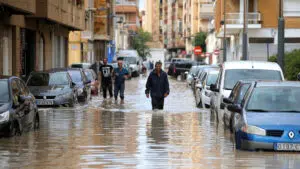More than 71% of critical infrastructures located in flood-prone areas in Spain are in a situation of very serious danger, according to the report “Flood-prone Critical Infrastructures in Spain“, prepared by the Sustainability Observatory (OS). The document warns that climate change is accelerating the risk and exceeding the limits predicted by historical models.
The report identifies 10,197 facilities within areas with a possibility of flooding every 500 years, although recent events show that this frequency has already been surpassed. Extreme rains, increasingly frequent and intense, are turning vast regions of the country into vulnerable scenarios.
Of this total, 71% present a very serious risk, 13% serious, and 16% mild. The study focused on 4,340 essential infrastructures, classified into six categories: vulnerable populations, state security, health, environmental security, basic services and industry, and transportation.
Catalonia concentrates 37% of the most threatened facilities, followed by Galicia, the Basque Country, Andalusia, Castile and León, Murcia, the Valencian Community, and Aragon. These figures reflect the magnitude of the risk and the urgent need to implement adaptation strategies in the face of the impacts of climate change.
 Spain, under water: floods affected several of its cities. Photo: AP News.
Spain, under water: floods affected several of its cities. Photo: AP News.
Cities at risk: the challenge of a flooding country
The most vulnerable areas include 420 nursing homes, 1,126 schools, and 232 kindergartens, located within high-risk zones. Added to these are campsites, health centers, barracks, treatment plants, and electrical substations. This exposure jeopardizes not only essential services but also the lives of the most fragile populations.
In the area of state security, the report notes 51 fire stations, 116 Civil Guard barracks, and 114 police stations at risk of flooding. In health, there are 112 hospitals and 3 medical centers, while in environmental security there are 375 treatment plants, 82 radioactive facilities, and 77 chemical plants.
Energy and water infrastructures are also compromised: 415 electrical substations, 282 supply and sanitation networks, and 455 industries are within potentially floodable areas. In transportation, there are 262 critical infrastructures, including stations, roads, and airports.
Factors aggravating urban floods
Floods in Spain are not only a consequence of increased extreme rains. Uncontrolled urbanization, soil sealing, and the lack of natural drainage amplify the impact of rainfall. Cities replaced permeable soil with asphalt and cement, preventing water from seeping in and causing runoff to accumulate.
Added to this is the loss of natural ecosystems like wetlands, marshes, and secondary channels, which historically functioned as natural sponges. Deforestation and excessive river channeling reduce their capacity to cushion floods, increasing the risk of overflows in urban areas.
The climate change intensifies this scenario. Torrential rains are now shorter but more violent, and they combine with drier summers that harden the soils, reducing their absorption capacity. In recent events, such as the 2024 DANA in Valencia, more than 16,000 additional hectares overflowed, showing that forecasting models are no longer sufficient.
 Spain, under water: floods affected several of its cities. Photo: AP News.
Spain, under water: floods affected several of its cities. Photo: AP News.
Urgent solutions for resilient planning
The Observatory proposes creating early warning systems, implementing a flood risk label on public and private infrastructures, and prohibiting new constructions in vulnerable areas. It also recommends reviewing urban plans, incorporating nature-based solutions, and adapting critical infrastructures to new climate scenarios.
Among the most effective measures are the restoration of wetlands, the reforestation of watersheds, and the construction of urban green spaces capable of absorbing rainwater. These natural solutions reduce the risk of floods and improve air quality and local biodiversity.
The report concludes that floods should no longer be considered exceptional phenomena, but rather a structural reality. Protecting life, essential services, and the environment requires a new urban culture based on resilience, sustainable planning, and climate justice. Only then will it be possible to prevent water, the source of life, from becoming a recurring threat.
